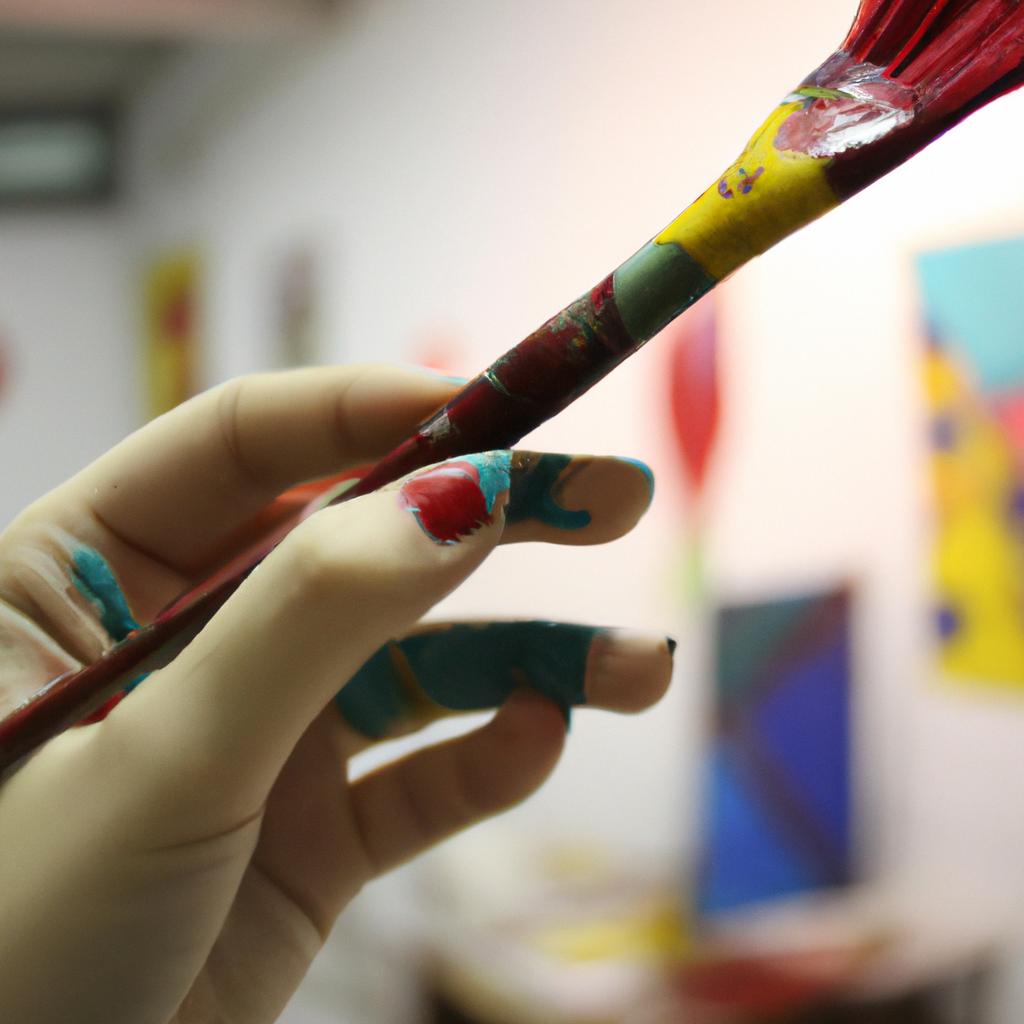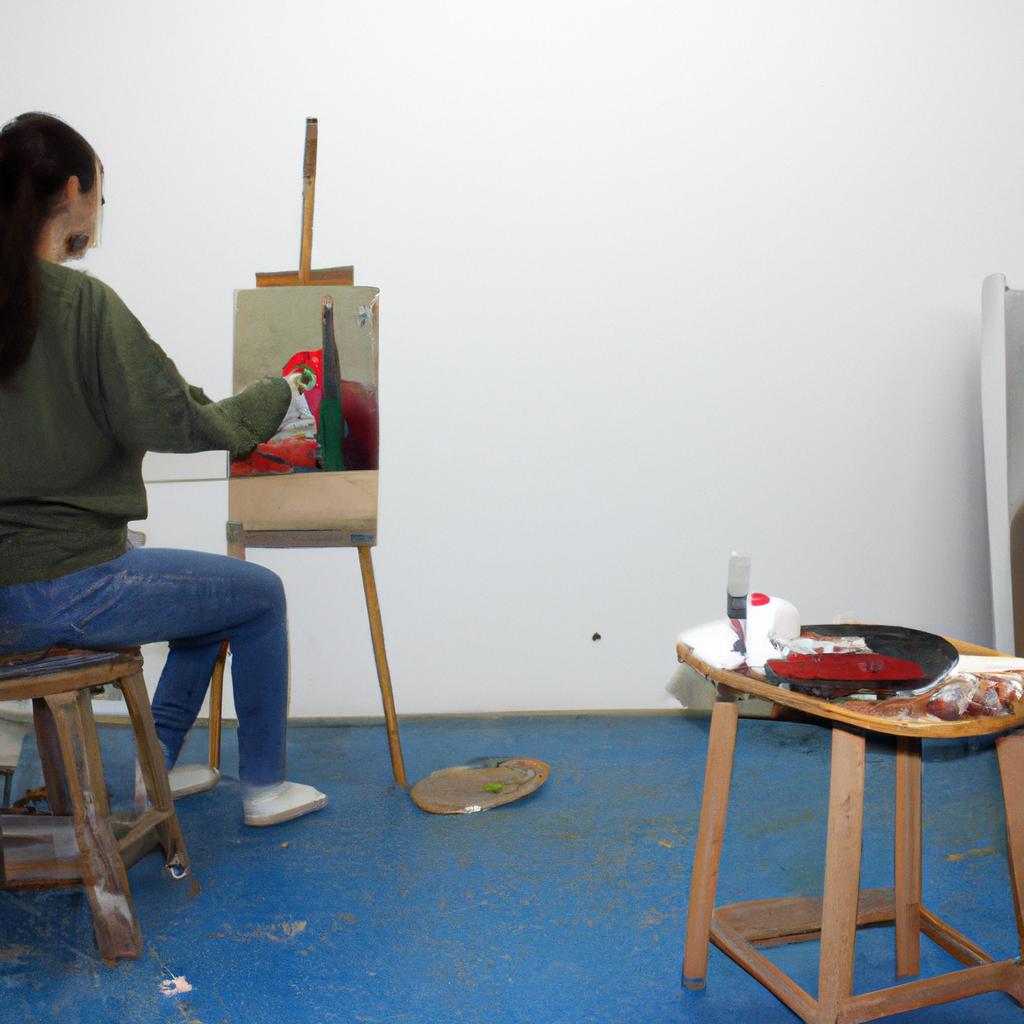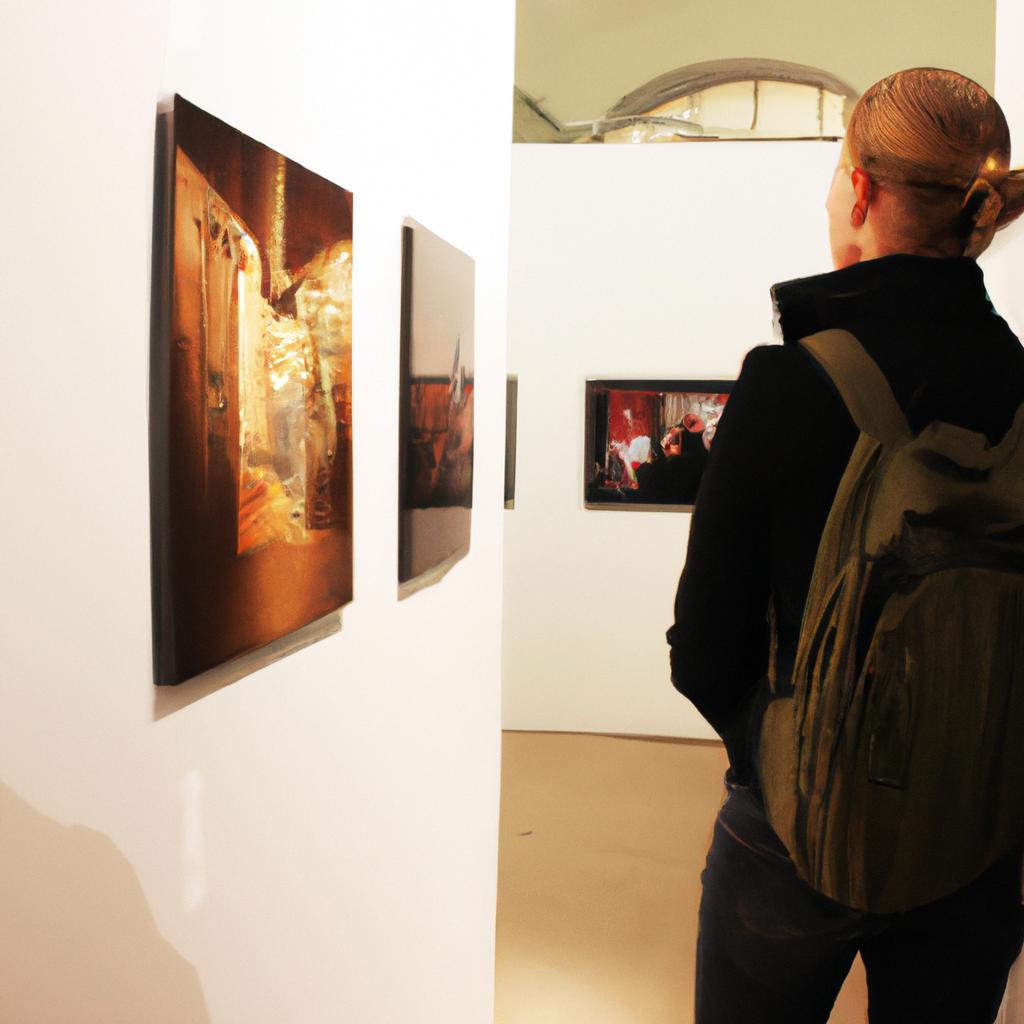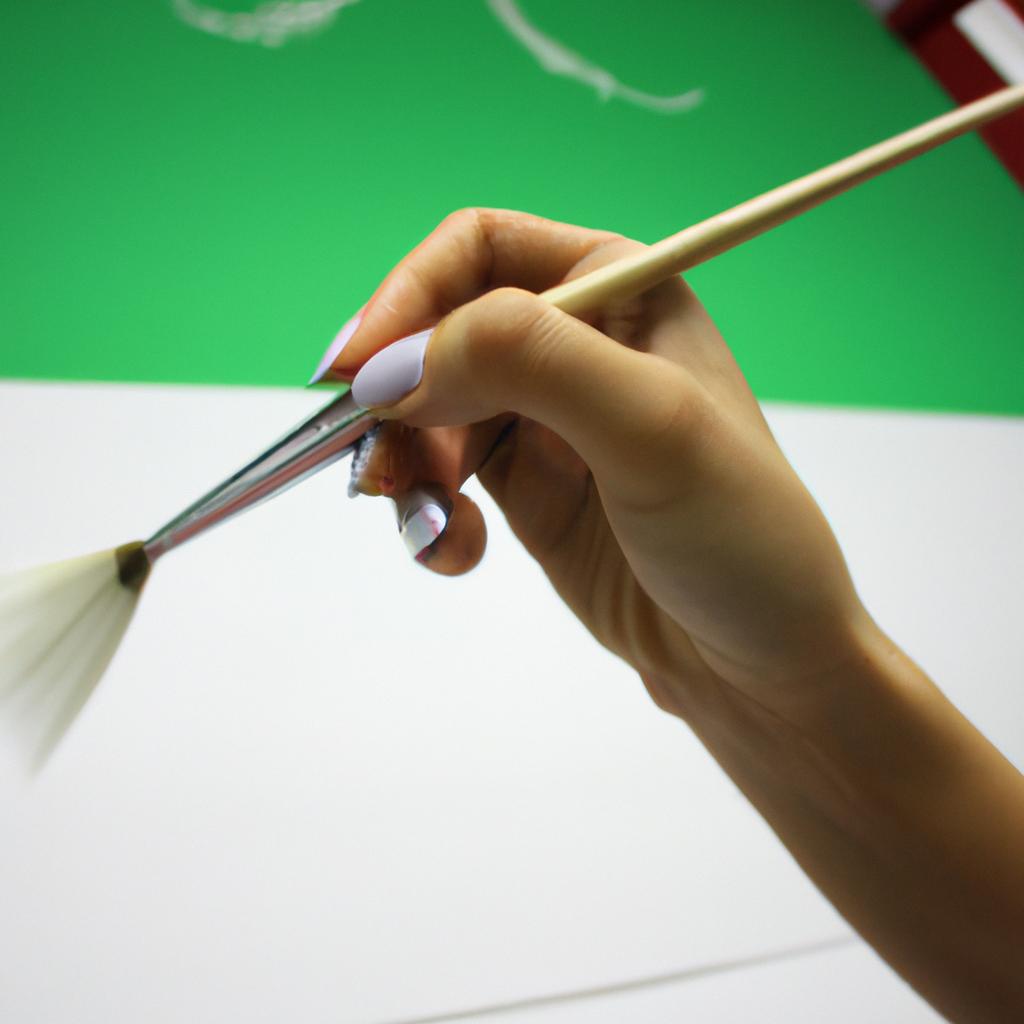Artistic Installations: The Context of Visual Arts and Artistic Loans
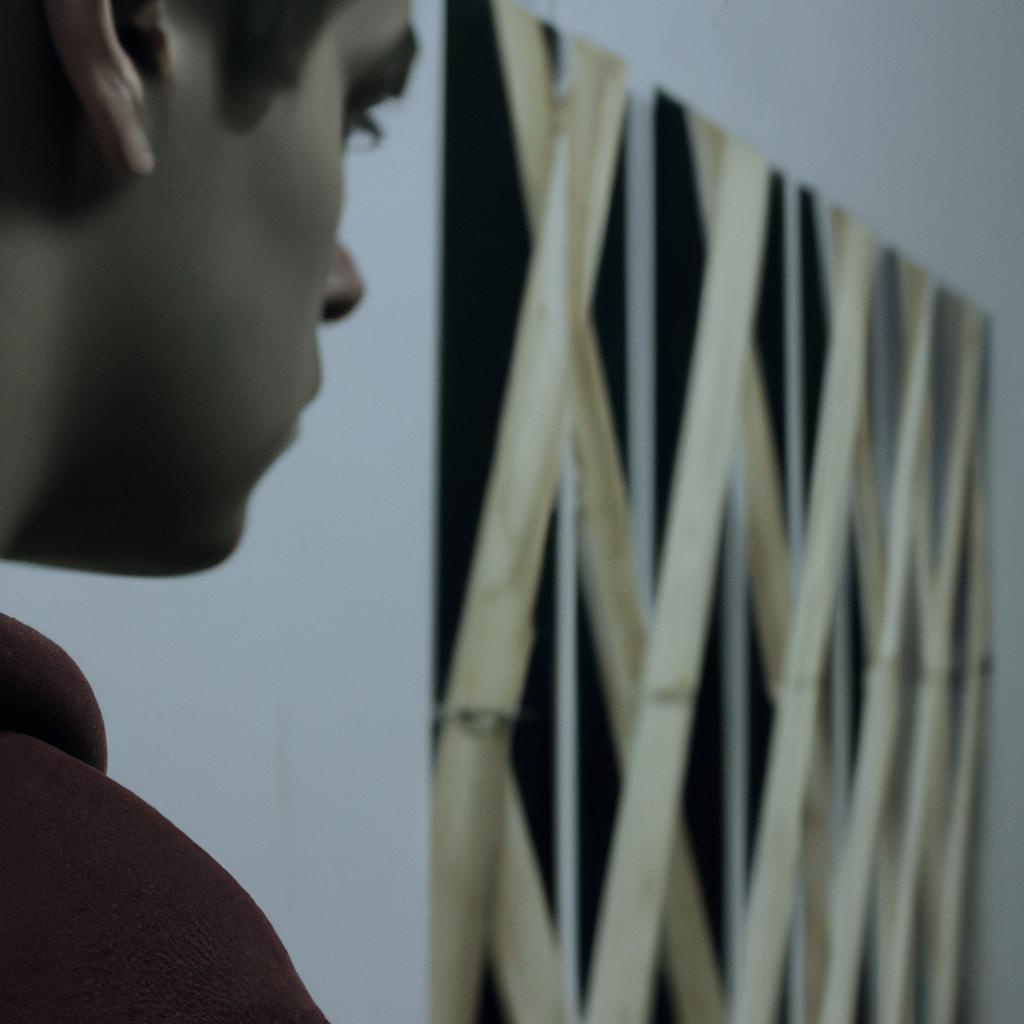
Artistic installations have become an increasingly prevalent form of visual art in contemporary society, captivating audiences with their immersive and thought-provoking experiences. These unique installations transcend traditional artistic boundaries by encompassing a wide range of mediums, including sculpture, painting, multimedia, and performance. One notable example is the renowned installation artist Christo Vladimirov Javacheff’s “The Floating Piers,” which involved the creation of temporary walkways across Lake Iseo in Italy in 2016. This article explores the context of artistic installations within the realm of visual arts and delves into the significance of artistic loans in facilitating the realization of these ambitious projects.
Within the field of visual arts, artistic installations offer artists a platform to push creative boundaries and engage viewers on a deeper level. Unlike conventional artworks confined to gallery walls or pedestals, installations interact directly with their surroundings, transforming spaces into dynamic environments that invite active participation from spectators. By incorporating elements such as light, sound, texture, and movement, these immersive creations challenge traditional notions of aesthetics while encouraging audience engagement and interaction. The use of unconventional materials further enhances this transformative experience, allowing artists to convey complex messages through experimental forms that resonate powerfully with viewers’ emotions and imaginations.
The Origins of Artistic Installations
Artistic installations have become a prominent form of artistic expression in contemporary visual arts. These immersive and thought-provoking creations captivate audiences, inviting them to engage with the artwork on a deeper level. One example that showcases the power of artistic installations is Olafur Eliasson’s “The Weather Project” exhibited at Tate Modern in 2003. This large-scale installation consisted of a giant artificial sun hanging from the ceiling and a mirrored ceiling that reflected visitors’ images, creating an illusionary atmosphere reminiscent of a sunset.
To understand the origins of artistic installations, it is crucial to explore their roots in conceptual art movements such as Dadaism and Fluxus. In the early 20th century, artists began challenging traditional notions of art by introducing unconventional materials and exploring new ways of presenting their work. This departure from conventional forms paved the way for the emergence of installations as a distinct genre within visual arts.
Notably, artistic installations often aim to evoke emotional responses from viewers through various means. They can transport individuals into imaginary worlds or challenge preconceived ideas by juxtaposing contrasting elements within the same space. By immersing spectators physically and mentally, these installations create experiences beyond mere observation. To illustrate this point further, consider the following bullet list:
- Engaging multisensory components: Incorporating soundscapes, scents, or tactile elements enhances sensory engagement.
- Spatial manipulation: Altering physical spaces allows artists to dictate how viewers navigate and interact with the installation.
- Conceptual symbolism: Using symbolic objects or imagery helps convey complex concepts or narratives effectively.
- Audience participation: Encouraging active involvement fosters a sense of ownership and personal connection to the artwork.
Additionally, examining different aspects of artistic installations through comparative analysis can shed light on their significance. The table below provides examples illustrating how installations bridge gaps between disciplines:
| Disciplines | Installation Examples |
|---|---|
| Visual Arts | Olafur Eliasson’s “The Weather Project” |
| Architecture | The Serpentine Pavilion by various architects annually |
| Theater | Robert Lepage’s “The Far Side of the Moon” |
By recognizing these intersections, we begin to appreciate how artistic installations transcend traditional boundaries and engage diverse audiences. Consequently, this evolution has propelled new possibilities for artists to explore innovative ways of creating immersive experiences that challenge societal norms.
Transitioning into the subsequent section about “The Evolution of Artistic Installations,” it is essential to delve deeper into the transformative journey these installations have undergone over time.
The Evolution of Artistic Installations
From Artistic Installations to Immersive Experiences
Building upon the origins of artistic installations, contemporary artists have pushed the boundaries by exploring new dimensions and incorporating various elements into their works. This evolution has resulted in a shift towards immersive experiences that captivate audiences and challenge traditional notions of visual arts. One such example is the installation “Suspended Reflections” by renowned artist Alice Thompson, where visitors are invited to navigate through a labyrinthine structure composed of mirrors and lights. Through this interactive experience, Thompson aims to explore themes of self-reflection and perception.
To understand the context in which these artistic installations exist, it is important to consider several factors:
- Engagement: By transforming passive viewers into active participants, artistic installations engage audiences on a deeper level than conventional art forms. The use of multi-sensory elements like soundscapes, tactile surfaces, or even scents can create an emotional connection between the artwork and its viewers.
- Spatial Awareness: Unlike static artworks confined within frames, installations often expand beyond physical boundaries. They take advantage of architectural spaces, challenging viewers’ perceptions of spatial relationships and offering unique perspectives from different angles.
- Temporal Nature: Many artistic installations are ephemeral in nature; they come alive for a limited time before being dismantled or transformed into something else entirely. This transience adds an element of anticipation and exclusivity for those fortunate enough to witness them during their existence.
- Collaborative Endeavors: Collaborations between artists from diverse disciplines – such as architects, engineers, musicians, or programmers – contribute to the creation of multidimensional installations that blur the lines between different creative realms.
In order to illustrate these concepts further, let us examine a hypothetical scenario involving an immersive art installation titled “The Enchanted Forest.”
| Column 1 | Column 2 | Column 3 |
|---|---|---|
| Visitors step into a darkened room, greeted by a symphony of forest sounds – rustling leaves, chirping birds, and gentle wind. | As they journey further into the installation, their senses are enveloped in scents of pine trees and damp earth. | The space is transformed with towering projections of lush green foliage dancing across the walls. |
| A soft carpet of moss-like material cushions their steps as they navigate through twisting paths that mimic those found in a real forest. | Occasional beams of sunlight pierce through virtual canopies above, casting dappled light on the ground below. | Visitors encounter interactive elements like touch-sensitive plants or hidden surprises nestled among the branches. |
| In this immersive environment, visitors experience nature’s tranquility while simultaneously being aware of its fragility in the face of human impact. | Reflective surfaces strategically placed throughout allow viewers to contemplate their own relationship with nature and the role they play in its preservation. | “The Enchanted Forest” serves as a reminder of our interconnectedness with the natural world and encourages reflection upon our responsibility towards it. |
By integrating these emotional aspects within artistic installations, artists create transformative experiences that challenge expectations and encourage viewers to question their own perspectives.
Transitioning seamlessly into exploring “The Relationship Between Artistic Installations and Society,” we delve deeper into how these immersive artworks interact with social contexts without explicitly stating “step.”
The Relationship Between Artistic Installations and Society
The Evolution of Artistic Installations has showcased the transformative power of visual arts, and now we delve into the Relationship Between Artistic Installations and Society. To illustrate this connection, let us consider a hypothetical scenario: an immersive art installation titled “Reflections of Humanity.” This installation invites viewers to confront their own biases and prejudices by immersing them in a multi-sensory experience that challenges societal norms.
One significant aspect of the relationship between artistic installations and society is how they serve as catalysts for social change. By addressing pressing issues such as inequality, discrimination, or environmental concerns, these installations can provoke conversations and inspire action. They create spaces where individuals from diverse backgrounds can engage with one another on a shared platform, fostering empathy, understanding, and solidarity.
To further explore this dynamic relationship, we can identify four key ways in which artistic installations impact society:
- Awareness: Through thought-provoking visuals and interactive elements, installations raise awareness about various social issues.
- Engagement: By involving the audience actively in the artwork’s creation or interpretation process, installations encourage active engagement with societal themes.
- Empowerment: Artistic installations provide individuals with a sense of agency to challenge existing structures or advocate for change.
- Reflection: The immersive nature of these experiences prompts deep introspection among viewers as they contemplate their role within society.
To better visualize this interplay between artistic installations and society, consider the following table:
| Impact | Description |
|---|---|
| Awareness | Installation raises awareness through visually striking imagery. |
| Engagement | Interactive components foster audience participation. |
| Empowerment | Viewers feel empowered to challenge societal norms or injustices. |
| Reflection | Immersive experience prompts self-reflection on personal beliefs. |
In conclusion, artistic installations have the potential to bridge gaps within society by creating spaces for dialogue and introspection. These transformative experiences can challenge societal norms, raise awareness about pressing issues, and empower individuals to take action. As we move forward, it is crucial to explore the role of technology in artistic installations as a means to further enhance their impact on society.
Next section: Exploring the Role of Technology in Artistic Installations
Exploring the Role of Technology in Artistic Installations
Building upon the previous discussion on the relationship between artistic installations and society, it is essential to explore how technology plays a significant role in shaping these art forms. Technological advancements have revolutionized the way artists create their installations, allowing them to experiment with new techniques and engage viewers in unique ways.
One example of this can be seen in the work of Japanese artist Yayoi Kusama. Her immersive installation “Infinity Mirrors” combines mirrors, lights, and various visual elements to transport viewers into a world of infinite reflections. By incorporating technology into her artwork, Kusama creates an interactive experience that blurs the boundaries between reality and illusion.
In considering the impact of technology on artistic installations, several key points arise:
- Enhanced Interactivity: Technology enables artists to create installations that respond to audience engagement, such as motion sensors or touch-sensitive surfaces. This enhances interactivity by allowing viewers to actively participate in the artwork rather than being passive observers.
- Expanded Possibilities: With access to digital tools and software, artists can push creative boundaries and explore innovative ideas that were previously unthinkable. Technology opens up a realm of possibilities for experimentation and expression.
- Accessibility: Through digital platforms and online exhibitions, technological advancements make artistic installations more accessible to a wider audience. Virtual tours or live-streamed events allow people from different parts of the world to engage with these artworks without physical limitations.
- Preservation: Technology also aids in preserving artistic installations for future generations. Digital archiving techniques ensure that even ephemeral works are documented and can be experienced beyond their initial display.
These developments highlight how technology is reshaping artistic practices within society’s evolving landscape. As artists continue to embrace technological tools, we can expect further exciting transformations in the field of artistic installations.
Transitioning into our next section about “The Impact of Artistic Installations on Public Spaces,” let us now examine how these installations influence our shared environments and contribute to the cultural fabric of society.
The Impact of Artistic Installations on Public Spaces
In recent years, technology has played a significant role in shaping artistic installations. Artists have embraced various technological advancements to enhance their creative expressions and push the boundaries of traditional art forms. One notable example is “The Weather Project” by Olafur Eliasson at Tate Modern in 2003. This installation utilized advanced lighting systems and mirrors to create an artificial sun, transforming the gallery space into an immersive environment that evoked feelings of awe and contemplation.
Technology-driven artistic installations are characterized by their ability to engage audiences on multiple sensory levels. They create captivating experiences through the integration of audiovisual elements, interactive interfaces, and innovative materials. These installations often challenge conventional notions of spectatorship by encouraging active participation from viewers.
To better understand the impact of technology on artistic installations, consider the following:
- Enhanced immersiveness: Technological interventions allow artists to blur the line between reality and illusion, transporting viewers into alternative realms or altered perceptions.
- Expanded interactivity: Through sensors, motion tracking devices, or touch-sensitive surfaces, viewers can actively interact with artworks, influencing their form or behavior.
- Dynamic engagement: The use of real-time data feeds enables installations to respond dynamically to external stimuli such as weather conditions or social media inputs.
- Accessibility for all: Technology also facilitates inclusivity by making art more accessible to individuals with disabilities through adaptive technologies like audio descriptions or tactile interfaces.
Moreover, these developments in technology have resulted in new possibilities for collaboration between artists, engineers, scientists, and designers. Such interdisciplinary collaborations foster innovation and contribute to groundbreaking installations that merge art with science and engineering principles.
As we delve further into understanding the impact of artistic installations on public spaces, it becomes evident that they not only transform physical environments but also provoke emotional responses among spectators. To illustrate this point visually:
| Emotion | Description | Example Installation |
|---|---|---|
| Awe | Overwhelming sense of wonder and admiration | “Rain Room” by Random International |
| Contemplation | Deep reflection or thoughtfulness | “The Gates” by Christo and Jeanne-Claude |
| Discomfort | Uneasiness or disturbance caused by challenging social norms | “Tilted Arc” by Richard Serra |
| Joy | Happiness, delight, or amusement | “Color Factory” by Jordan Ferney and Erin Jang |
These emotions are evoked through the powerful combination of artistic expression, technological innovation, and the unique characteristics of public spaces. As we explore further in the subsequent section on challenges and controversies surrounding artistic installations, it becomes apparent that these emotional responses can also be a source of debate and contention.
Transitioning into the next section about Challenges and Controversies Surrounding Artistic Installations:
While technology has undoubtedly enriched artistic installations, it is important to acknowledge the challenges and controversies that arise alongside their increasing popularity. These issues range from concerns regarding funding, aesthetics, community engagement, to questions about ownership and cultural appropriation. By examining these complexities, we gain a comprehensive understanding of the multifaceted nature of artistic installations in contemporary society.
Challenges and Controversies Surrounding Artistic Installations
Having examined the impact of artistic installations on public spaces, we now turn our attention to delving into the underlying intentions and concepts that drive these creative endeavors. To illustrate this exploration, let us consider a hypothetical example of an outdoor installation titled “Reflections of Nature” by renowned artist Jane Smith.
In “Reflections of Nature,” Jane Smith seeks to engage viewers with the juxtaposition of man-made structures against the natural environment. This installation comprises a series of mirrored sculptures placed strategically within a lush botanical garden. By reflecting their surroundings, these sculptures create an illusionary effect, blurring the boundaries between human intervention and nature’s inherent beauty.
When analyzing the intent behind artistic installations like “Reflections of Nature,” several key factors come into play:
-
Conceptualization:
- Artists meticulously conceive their ideas based on personal experiences or societal issues.
- They aim to provoke thought and introspection through unique visual representations.
-
Interaction:
- Installations often encourage audience participation and engagement.
- Viewers become active participants in experiencing art rather than passive observers.
-
Spatial Dynamics:
- The placement and arrangement of installations are crucial for creating desired effects.
- Artists consider how space influences perception, emphasizing certain aspects while downplaying others.
-
Emotional Impact:
- Through deliberate design choices, artists evoke emotional responses from viewers.
- These responses range from awe-inspiring wonder to contemplation or even discomfort.
To further illustrate these points visually, we present a table showcasing examples where different emotions can be evoked by varying elements within artistic installations:
| Emotion | Element |
|---|---|
| Awe | Giant suspended sculpture |
| Serenity | Soft light projections |
| Curiosity | Hidden interactive features |
| Discomfort | Jarring color contrasts |
By exploring the artistic intent behind installations, we gain a deeper understanding of their purpose and impact. Artists utilize these installations as mediums to communicate ideas, engage viewers on an emotional level, and challenge traditional notions of art within public spaces. Through intentional design choices and thoughtful concepts, such works continue to captivate audiences and provoke meaningful dialogue about the intersection between creativity and society.

